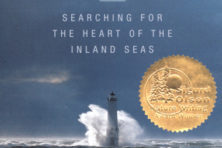Helping the Great Lakes Find Balance
- Share
- Tweet
- Pin
- Share

by BILL BERRY
When the Peninsula Pulse asked me to contribute a piece on water issues in the Great Lakes, I couldn’t say no, even though I knew it would take some digging.
It’s an incurable habit. I’ve spent 50 years covering the environment, often water issues, as a journalist, researcher and author. Growing up in Green Bay, I learned early on how important Lake Michigan is to the region. In the 1950s, when artesian wells that provided drinking water for the city started drying up, the solution was a pipeline to the lake. Saved by Lake Michigan!
We then had plenty of water for our public swimming pools. The city built those pools after the lower Green Bay became so polluted by industrial and municipal wastes that popular swimming spots were closed. On the way home from the pool, my buddy and I might sneak a cigarette down by the dirty East River, since no one would go there. We steered clear of the Fox River, choked with effluent and nearly dead.
Later in life, I joined high school pals in the annual smelt-fishing ritual, that big party along the shores of the bay and lake. We didn’t know that the smelt were non-native fish. Neither were the alewives that fouled beaches up and down the peninsula in huge die-offs.
The Clean Water Act (CWA) of 1972 brought big water-quality improvements, but the Great Lakes, the largest fresh-water system in the world, has endured a host of other problems. Today, invasive species like the round goby fish, rusty crayfish, and zebra and quagga mussels, have dramatically impacted the lakes, decimating fisheries. In the bay, a dead zone develops regularly.

So, do we throw up our arms in despair, especially when we add climate change to the mix?
Well, I’m pinning my hopes on the work of fisheries experts working to help the lakes find their balance. Many of these limnologists, fisheries biologists and, yes, concerned journalists, are young, smart and talented. They’ve helped grow our collective understanding immensely. They are people like Andrew Tucker, a conservation scientist with the Nature Conservancy (TNC) in South Bend, Indiana, and his colleague, Kari Hagenow, a coastal resilience specialist working to reduce nonpoint runoff and flooding to stem the growth of the dead zone in the bay. They are Yvonne Drebert and Zach Melnick, a husband-wife team that produces cinema documentaries on environmental topics from their base on Bruce Peninsula in Ontario, Canada.
As Tucker notes, “the Great Lakes has a pretty incredible infrastructure of scientists and managers” – and lots of partners – from tribes to local, state and national governments, and nonprofits like land trusts and foundations – all providing resources into efforts to preserve these gorgeous Great Lakes.
Everyone alive today has known only a dramatically altered Great Lakes system. Helping nature find some balance is a long game, but my spirits were buoyed talking to some of these talented people. Drebert and Melnick comprise Inspired Planet productions. Last September, at the Kress Center in Egg Harbor, TNC hosted a sneak preview of one of their current projects: All Too Clear: Restoring the Great Lakes. The first installment of the three-part documentary is nearing completion, and will be ready for audiences later this year.

The title comes from the fact that while Great Lakes waters are remarkably clear, it’s nothing to cheer. Quagga mussels have all-but sucked the life out of the system by filtering out the plankton so crucial to the lake food web. The couple uses an underwater drone to show the extent of the mussel invasion, with stunning footage at depths of hundreds of feet showing lake bottoms covered with quaggas that first arrived in Lake Michigan in 1997.
The quaggas have outcompeted zebra mussels (circa 1989 to Lake Michigan), another eastern European import that came to the Great Lakes courtesy of ballast water released from oceangoing vessels, a practice that has thankfully been regulated. Peninsula residents who remember beaches covered by razer-sharp zebra mussel shells may find some small consolation in that. But unlike zebras that need hard surfaces, quaggas can also colonize soft surfaces – and they have gone deep, in numbers so high we can’t count. It is said that quagga mussels filter all of Lake Michigan’s vast waters once a week, starving other life, including native whitefish.
A New Balance – Over Time
In this challenging environment, lake experts are working toward a new balance, including stemming the spread of more invasives and restoring forage fish to the food web. One key is helping native species recover. “Generally, natives are hardier, more adaptive,” Tucker said. “To some extent, we’ve already seen how native species are adapting to the new normal.”
There’s evidence that whitefish and lake trout are switching diets to consume mussels, he said, and Drebert noted that research in the Green Bay shows whitefish are now hunting and feeding on round gobies. This is a major change for whitefish, which historically have fed on zooplankton and other small creatures. And since the Green Bay is now the main source of whitefish for Door County fish boils, it’s sort of a good thing. Drebert finds hope, but added “Nature needs time to respond.”

We’ve thrown nature some curveballs. For much of the last 70 years, the lakes were full of those skinny, silvery alewives – nonnative fish that provided food for lake trout and other native species, along with the salmon introduced to bolster the fishery. It turned out, Tucker said, that alewives are what fisheries folks call “wimpy.” Likely for a variety of reasons, their populations have plunged, and they’re not piling up on beaches.
Of course, if we hadn’t decimated native fish species by overfishing, alewives may not have thrived at all. They filled a void in the middle of the food chain. As Tucker and Drebert noted, one key to balance is to reintroduce native forage fish like the near-shore cisco – sometimes called lake herring – that were once abundant and that don’t mind low-nutrient environments. That involves reef restoration, including removing invasive species if needed, and introducing hatchery-raised fish.
Even in the current quagga era, there are winners and losers, Drebert said. Smallmouth bass, for instance, are doing well. They are sight feeders, and there’s obviously plenty of clear water. Perch and lake trout are hanging in there.
But, as Tucker noted, “We need to continue to work to better understand some of these really complicated food-web dynamics.” For instance, why are whitefish doing OK in the bay as their numbers decline in most of the Great Lakes? And will they continue to thrive in the bay, which is subject to dead zones on an increasing number of days per year?
Dead zones are nothing new in the bay, and they creep well up the Door Peninsula, but their source has changed. The CWA cleaned up point sources, but nonpoint runoff is now the culprit – rainfall and snowmelt moving over and through the ground, picking up and carrying away natural and human-made pollutants. Nutrients and sediment from nonpoint sources in the lower watershed push into the bay, trapping cold water below and robbing it of oxygen. Hagenow works with municipalities and other partners to control flash floods rumbling out of the East River, into the Fox, and then the bay, using mostly natural remedies like buffers, rain gardens and forest restoration.
Of course, those flash floods will increase with climate change.
Yes, it’s complicated. But good people are working hard to help the Great Lakes find balance.
Great Lakes Food for Thought
The Great Lakes commercial, recreational and tribal fisheries are collectively valued at more than $7 billion annually and support more than 75,000 jobs, according to the Great Lakes Fishery Commission.
Great Lakes partners are working to improve ballast-water handling on lake-going vessels. Ballast-water regulations for ocean-going ships were implemented in 2008.
Dan Egan’s 2017 book, The Death and Life of the Great Lakes, is a deep dive into the many challenges facing the Great Lakes. Egan, a Green Bay native, is also author of The Devil’s Element: Phosphorous and a World Out of Balance, relevant to the lakes and the Green Bay’s dead zone.
Climate change? Abrahm Lustgarten’s recently published book, On the Move: The Overheating Earth and the Uprooting of America,” focuses on climate-driven migration if the climate continues to heat up. Portions of the South, Southwest and costal America will become unlivable, he says. Where will people go? The Great Lakes. Why? The world’s largest fresh-water lake system and possibly fewer climate-change impacts in our region. Also, in-fill capacity in Rust Belt industrial centers that have lost population.
–Bill Berry
Journalist and author Bill Berry lives in Stevens Point and visits Door County often. He has written about the environment and conservation for more than five decades. His 2014 book, Banning DDT: How Citizen Activists in Wisconsin Led the Way, was named the top nature book of the year by the Midwest Independent Publishers Association.



